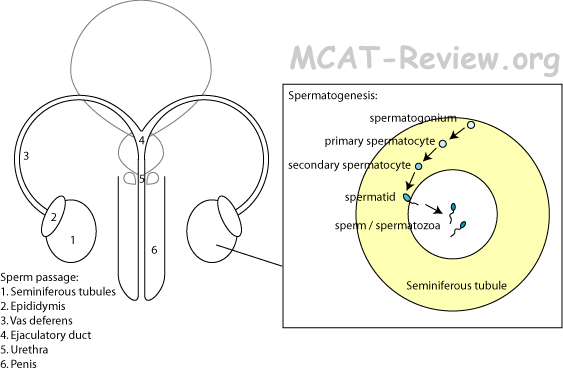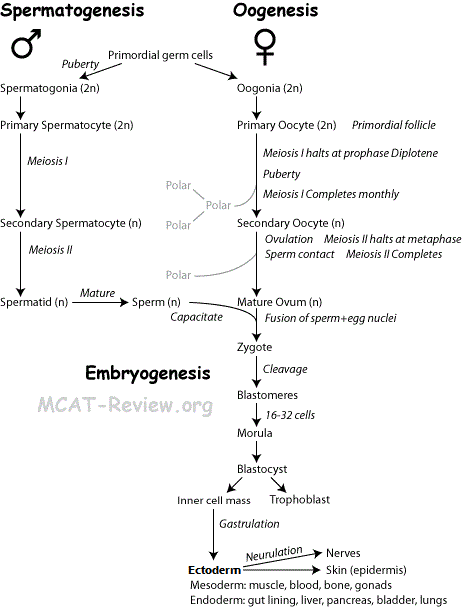|
|
Reproductive System
- Male and female reproductive structures and their functions
- gonads
- male: testes
- makes sperm in the seminiferous tubules.
- makes testosterone.
- external.
- female: ovaries
- houses immature egg, which matures monthly after puberty.
- makes estrogen.
- internal.
- genitalia
- male: testes, penis, and various ducts and glands.
- sperm made in the seminiferous tubules.
- stored in the epididymis.
- travels through vas deferens → ejaculatory duct → urethra → penis
- mnemonic: seven up = Seminiferous tubules, Epididymis, Vas deferens, Ejaculatory duct, nothing, Urethra, Penis.
- female: ovaries, fallopian tubes, uterus, vagina
- Monthly cycle: primary oocyte matures into secondary oocyte every month. To prepare for it, the endometrium thickens. If fertilization doesn't occur, menses occur, and the cycle begins anew.
- GnRH = stimulates release of FSH and LH.
- FSH = folicle stimulating hormone = stimulates growth and maturation of follicle.
- Follicle = houses oocyte and produces estrogen.
- Estrogen = normally inhibits LH and FSH, but causes LH surge when it reaches a certain threshold.
- Estrogen reaches this threshold → surge of LH occurs.
- LH = leutinizing hormone = luteinizing hormone = stimulates the outer cells of the follicle = turns it into corpus luteum + maintains it.
- LH surge triggers primary oocyte → secondary oocyte → rupture of follicle.
- Corpus luteum = makes estrogen and progesterone = maintains endometrium.
- No fertilization → LH falls → corpus luteum dies → estrogen and progesterone fall → endometrium dies (menses) → cycle begins anew with FSH and LH re-rising.
- Fertilization occurs → implanted embryo releases hCG → hCG mimics LH to maintain corpus luteum → estrogen and progesterone maintained by corpus luteum → placenta takes over the responsibility of making estrogen and progesterone later on.

- differences between male and female structures
- male: mostly external. Shared passage with urinary tract.

- female: mostly internal. Separate passage from urinary tract.

- Gametogenesis by meiosis

- Male = spermatogenesis = occurs in the seminiferous tubules.
- Spermatogonium (2n) = stem cell. Mitosis of spermatogonium can either create more spermatogonium or create primary spermatocyte.
- Spermatogonium (2n) → mitosis → primary spermatocyte (2n). Occurs after puberty.
- Primary spermatocyte (2n) → meiosis I → Secondary spermatocyte (n).
- Secondary spermatocyte (n) → meiosis II → spermatid (n).
- Spermatid (n) → mature → sperm (n). The fancy name for sperm is spermatozoa.
- Female = oogenesis = occurs in the ovaries, then fallopian tubes.
- Oogonium (2n) = stem cell.
- Oogonium (2n) → mitosis → primary oocyte.
- Primary oocyte (2n) arrests at prophase I (occurs before birth). One comes out of arrest every month (between puberty and menopause).
- Primary oocyte (2n) → meiosis I → secondary oocyte (n). Ruptures from ovary follicle into the fallopian tube.
- Secondary oocyte (n) arrests at metaphase II. Comes out of arrest if fertilization occurs.
- Secondary oocyte (n) → meiosis II → ovum (n).
- Ovum and sperm
- differences in formation
| Male and female gametogenesis side by side |
| Male |
Female |
Difference |
| Spermatogonium (2n) |
Oogonium (2n) |
Spermatogonium renews its population by mitosis throughout life. Oogonium stops renewing its population sometime before birth |
| Primary spermatocyte |
Primary oocyte |
Primary oocye arrests at prophase I |
| Secondary spermatocyte |
Secondary oocyte |
Secondary oocyte arrests at metaphase II |
| Sperm |
Ovum |
Between the secondary spermatocyte and the sperm, there's the spermatid |
- differences in morphology
- Sperm = motile = flagella.
- Egg = non-motile = round.
- relative contribution to next generation
- Sperm contributes DNA only (the egg actively destroys sperm mitochondria).
- Egg contributes DNA + everything else (mitochondria, organelles, epigenetics).
- Reproductive sequence (fertilization, implantation, development, birth)
- fertilization: sperm + egg → zygote
- implantation:
- zygote
- morula (solid ball)
- blastula (sea urchins) or blastocyst (mammals)
- the blastocyst is the one that implants in the endometrium
- development:
- zygote
- blastocyst
- implantation
- gastrulation
- organogenesis
- Birth:
- Switch from getting oxygen from mom's blood → breathing.
- Switch from getting nutrients from mom's blood → suckling.
- Fetal circulation (which bypasses lungs and liver) → normal circulation (by closing off ducts and opennings).
Embryogenesis
- Stages of early development (order and general features of each)
- fertilization
- Sperm meets egg
- Acrosomal reaction causes sperm to penetrate egg
- Cortical reaction causes egg to prevent additional sperm from penetrating
- Egg completes meiosis II
- Sperm and egg nuclei fuse
- cleavage
- Normal mitotic cell divisions: cell grows then divides, grows again, then divides.
- Cleavage = mitotic divisions without cell growth.
- blastula formation
- fertilization produces zygote
- cleavage produces a solid ball called the morula
- morula hollows out into the blastula or blastocyst
- blastula occurs in non-mammals
- blastocyst occurs in mammals
- blastocyst implants
- gastrulation
- first cell movements
- Cells from the surface migrate inwards.
- gastrulation occurs slightly different for different animals. Some by invagination, some by migration, some by splitting.
- In mammals, the cells start migrating inward at the primitive streak.
- formation of primary germlayers (endoderm, mesoderm, ectoderm)
- The cells that migrate inwards form the endoderm.
- The cells that remain outside is the ectoderm.
- The cells in the middle are the mesoderm.
- neurulation
- ectoderm → brain and spinal cord
- the ectoderm does so by folding into a tube
- Major structures arising out of primary germ layers
- endoderm = innermost layer = guts, lungs, and digestive internal organs (liver, pancreas).
- mesoderm = middle layer = muscle, blood and bone tissues, and interal organs (kidney and gonads).
- ectoderm = outermost layer = skin and nerves (including the brain).
Developmental Mechanisms
- Cell specialization = commitment followed by differentiation
- commitment = specification followed by determination
- specification = cell is just beginning to be commited to develope into a certain cell type. The commitment can be reversed at this stage.
- determination = irreversible commitment to become a certain cell type.
- differentiation = becoming a cell type and adopting its specialized functions.
- epidermal cells produce keratin to protect skin against abrasion.
- myocyte produce actin and myosin to make muscles contract.
- neurons make neurotransmitters to transmit electrochemical impulses.
- tissue types
- Epithelial: skin, lining of organs
- Connective: blood, bone, tendons, ligaments, cartilage
- Nervous: brain, spinal cord, nerves
- Muscle: skeletal, smooth, and cardiac muscle
- Cell communication in development
- Induction: one group of cells changing the behavior of an adjacent group of cells.
- inducer = the one that sends the signal for the other to change.
- responder = the one that gets the signal and changes.
- For example, the optic vesicle is able to induce the ectoderm to develope into lens.
- Another example is the induction of wing feathers in the chick by the dermal mesenchyme.
- Induction mechanisms: physical touching of cells (juxtracine) or by releasing chemicals (paracrine).
- Cell migration
- Gastrulation, neural crest cell migration
- Hirschprungs disease: defective neural crest cell migration
- Pluripotency: stem cells (able to differentiate into other cell types)
- Stem cells in bone can differentiate into osteoblasts or osteocytes
- Stem cells in bone marrow can differentiate into neutrophils, lymphocytes, red blood cells or platelets
- Gene regulation in development
- Differential gene transcription:
- modification of DNA (methylations) can shut off or turn on genes.
- modification on histones (methylations, acetylations) that wrap the DNA can shut off or turn on genes.
- to make or not to make transcription factors can regulate what genes get transcribed.
- Differential RNA processing:
- selecting what RNA make it outside the nucleus to be translated.
- alternative splicing of RNA.
- Translation regulation
- some mRNA are made to last longer than others (more proteins translated off of it), and some are made to be rapidly degraded (less proteins translated off of it).
- selective inhibition of translation of stored RNA in the oocyte. Get translated only when needed after fertilization.
- Post-translational regulation
- some proteins are inactive until modified by certain enzymes.
- active proteins can be selectively marked for degradation by ubiquitin.
- Programmed cell death
- apoptosis = programmed cell death.
- During apoptosis, strong proteases are activated and they digest the cell from within. In mammals, the proteases are called caspases.
- The spaces between our fingers are created by apoptosis.
- The tail of a tadpole undergoes apoptosis when it morphs into a frog.
- Existence of regenerative capacity in various species
- Newts can regenerate limbs
- Cells in their limb stump can dedifferentiate and revert back to stem cells
- Senescence and aging
- Every time a cell replicates, the telomere shortens. Eventually, they run out of telomeres
- As a person age, their cells acquire irreversible DNA damage by radiation and chemicals. Not all can be repaired, and they accumulate
|
|
